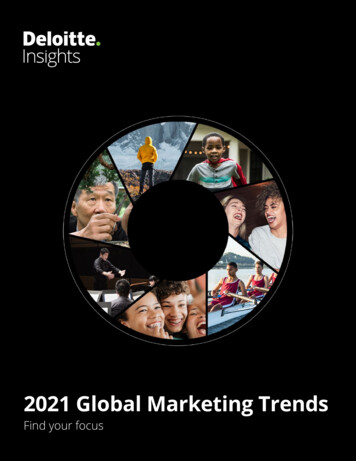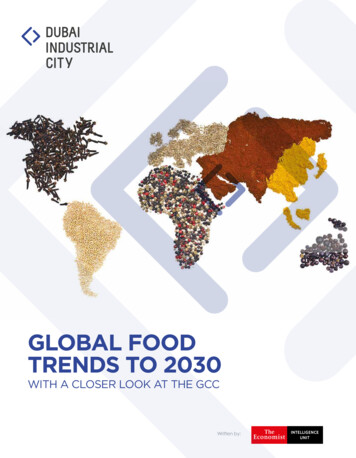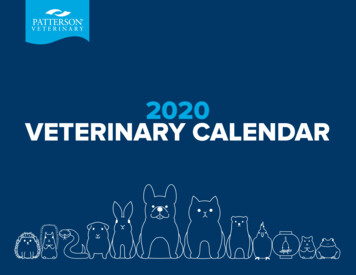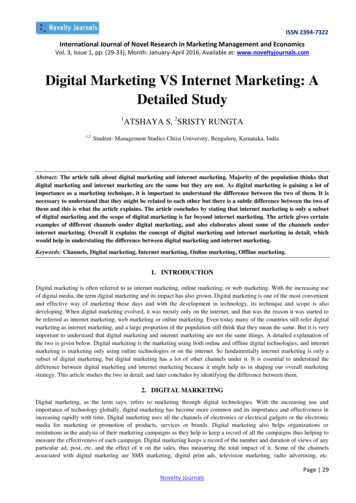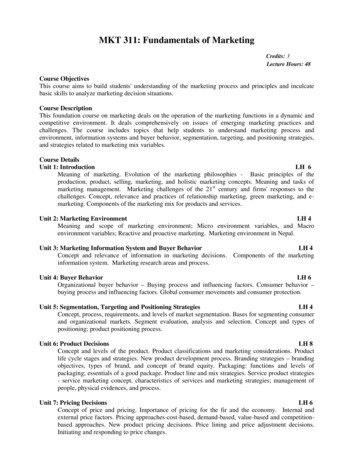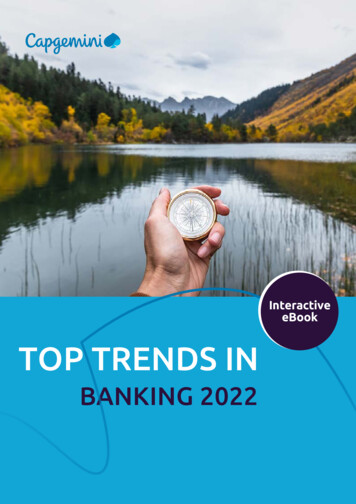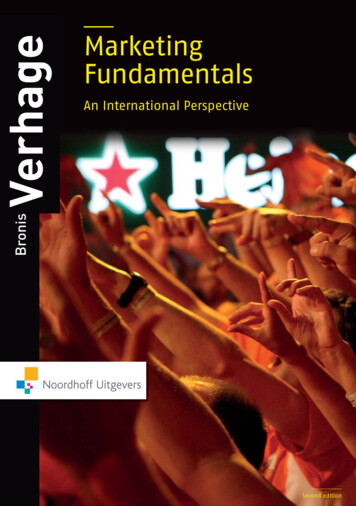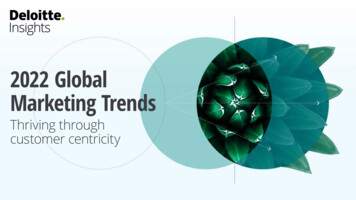
Transcription
2022 GlobalMarketing TrendsThriving through customer centricity1
About the Deloitte CMO ProgramDeloitte’s CMO Program supports CMOs as they navigate the complexities of the role, anticipate upcomingmarket trends, and respond to challenges with agile marketing. Read more on the latest marketingtrends and insights.Digital technology has changed the face of business. Across the globe, Deloitte Digital helps clients see what’s possible,identify what’s valuable, and deliver on it by combining creative and digital capabilities with advertising agency prowess,and the technical experience, deep business strategy, and relationships of the world’s largest consultancy. Deloitte Digitalempowers businesses with the insights, platforms, and behaviors needed to continuously and rapidly evolve to performbeyond expectations. Read more about Deloitte Digital’s world-class digital agency and its service offerings.2
2022 Global Marketing TrendsTable ofcontents410182634IntroductionThriving through customer centricity42Purpose—A beacon for growthHow brands can gain a competitiveadvantage through an authentic purposeAuthentically inclusivemarketingWinning future customers with diversity,equity, and inclusionBuilding the intelligentcreative engineHow unconventional talent strategiesconnect marketing to the customer50566465Designing a human-first dataexperienceInteracting with customers—and their data—to foster trustElevating the hybrid experienceHuman-centered design for our physicaland digital environmentsSupercharging customer servicewith AIReimagining AI strategies to unlock a true endto-end customer experienceRecognition and appreciationContact usMeeting customers in acookieless worldHow growth leaders are rethinking first-partydata strategies3
IntroductionThriving through customer centricityMacro trends, from theintegration of digitaland physical channelsto increasing calls fordiversity, are upendingthe marketing function.What can brands learnfrom their highest-growthcounterparts to thrive?4
2022 Global Marketing TrendsThe past 18 months forever redefined customer engagementstrategies—and with this change has come unprecedentedcomplexity. Consider just a few of the macro trends unfolding inthe market: In a world where people continuously toggle betweendigital and physical channels, linear customer journeys arealmost a relic of the past. Consumers expect more tailored andpersonalized experiences but, simultaneously, are more guardedin how their data is captured and deployed. Even the definitionof convenience has changed as people expect items and servicesto be available at the push of a button. Beyond products andservices, people are more attuned to what a brand stands for—and if it’s only maximizing profit, many will walk away before thebrand can even put an offer in front of them.These trends are creating just as much complexity within the fourwalls of the organization. As artificial intelligence becomes coreto the entire customer experience, teams are scrambling to findthe right mix of talent that elevates—and integrates—the creativeand analytical. In parallel, brands are continuously looking toensure their talent is just as representative and inclusive as theexperiences they hope to deliver to market. And underscoring allof this is the reality that marketing budgets shrunk to record lowsat a time when expectations are at an all-time high.1Given these trends, how can brands thrive in an increasinglycomplex world?We believe the answer requires holistically rethinking the waybrands engage with customers—and for good reason: When wesurveyed over 1,000 global executives, we found the highestgrowing brands (defined as those with 10% or higher annualgrowth) are moving beyond point solutions and comprehensivelyaddressing the entire customer experience—encompassingeverything from activating an enterprisewide purpose tooverhauling entire customer data strategies.Taking the lead from these high-growth organizations, we took amultifaceted approach to the 2022 Global Marketing Trends report.In addition to surveying executives from five countries, we polled11,500 consumers across the globe, as well as conducted 18in-depth interviews with executives from leading global brands(see sidebar “Research methodology” to learn more). In total,we identified seven trends that are customer-centric and take a360-degree view of the solution set.360-degree engagement:People, data, andexperiencesTo provide leaders with a road map to thriving in theseunprecedented times, we organized our trends into threesections: people, data, and experiences.However, these sections are not mutually exclusive endeavors.They comprise an interdependent system that, whenintegrated, forms the basis of dynamic customer experiences.5
IntroductionPutting people at the centerThe opening trends in our report build the foundation throughwhich everything else flows: the people the brand serves.Purpose—A beacon forgrowthExplores how high-growth brands arecutting through the noise of competingon price and quality alone and building acompetitive advantage by committing to andcommunicating their impact beyond profit.TREND 4Authentically inclusivemarketingFocuses on how marketers—and theiradvertisements—are generally the faceof what a brand stands for beyond profitmaximization to consumers. And aspopulations continue to become more diverse and increasinglyprioritize representation, it’s important to get the brandauthentically right or risk losing your customer of today—andthe future.Building the intelligentcreative engineIn a fast-paced world, marketers need atalent model that moves at the speed ofculture. This trend highlights how brandsare unleashing creative content that betterresonates with today’s world. This includes using agile cohorts6of creative and analytical talent to solve customer problems andseeking new forms of external talent, for example, by turninginfluencers from product spokespeople to creative agents.Building the data infrastructureThe proliferation of channels has led to myriad sources of data.However, more is not always better, and, in some cases, what’savailable today won’t be here tomorrow. Our next two chaptersprovide guidance in navigating this increasingly complex dataenvironment.Meeting customers in acookieless worldDiscusses how marketers should bepreparing for an environment where lessinformation will be available as third-partycookies continue to disappear. Further, wenote how high-growth brands are already ahead in their firstparty data strategies.Designing a human-first dataexperienceBut it’s not just about moving to a first-partydata strategy; designing a human-first dataexperience shifts the lens to consumers tobetter understand the balance betweenpeople finding the use of their data helpful and, well, creepy.Designing dynamic experiencesThe customer experience is the culmination of every step alongthe way. In this spirit, our final two chapters highlight how brandscan bring everything together to ensure their experiences matchtheir aspirations of delivering dynamic solutions to customers.Elevating the hybridexperienceLays out how brands can build dynamic,cohesive experiences in both their digitaland in-person environments through leadingprinciples from human-centered design.Supercharging customerservice with AIConsiders the consumer’s perspective toshow how timely offers and knowledgeablecustomer service can better help consumersmake purchase decisions. This trend revealshow artificial intelligence can be integrated with human service tobring the best of both to the entire customer journey.Together, these trends highlight that marketing is a powerful forcefor growth in designing customer experiences that foster trustand meet human needs.
2022 Global Marketing TrendsResearch methodologyTo ensure a globally relevant, cross-topic understanding of marketing and the customer experience, we conducted two global surveys and18 in-depth interviews with global executives.The Global Marketing Trends Executive Survey polled 1,099 C-suite executives from global companies located in the United States(62%), the United Kingdom (11%), France (9%), Japan (9%), and the Netherlands (9%) in April 2021. This survey asked chief executive,marketing, information, finance, operating, legal, and human resource officers their thoughts on a variety of topics driving the evolutionof the marketing function. As this report focuses on marketing and customer experience leaders, 50% of the respondents consistedof chief marketing officers or those with similar titles (such as chief experience officer and chief growth officer), with nearly equaldistribution across the other C-suite roles.All businesses (outside of the public sector) had at least US 500 million in annual revenues, with 73% having over US 1 billion.The Global Marketing Trends Consumer Survey polled 11,500 global consumers, ages 18 and above, in May 2021 across 19 countries:the United States, Canada, Mexico, Brazil, Chile, South Africa, Sweden, the United Kingdom, Italy, Ireland, France, Spain, Turkey,Switzerland, Denmark, Portugal, Japan, India, and China.Separately, executive interviews were conducted throughout 2021 and involved 18 executives who either currently or previously held chiefmarketing, customer experience, or executive officer roles. Their insights were key to uncovering the trends included in this report.7
IntroductionENDNOTE1.Kelly Blum and Gloria Omale, “Gartner says marketing budgets haveplummeted to 6.4% of overall company revenue in 2021,” press release,Gartner, July 14, 2021.ABOUT THE AUTHORSJennifer Veenstra jveenstra@deloitte.comJennifer Veenstra is the executive leader of Deloitte’s Global CMO Program. She focuses on CMO leadership,especially around the client experience, driving strategy, and digital transformation. Veenstra works across multipleindustry areas to help CMOs deliver enterprise growth and connect with customers around purpose. She has led thetransformation of the Deloitte Client Experience.Stacy Kemp stkemp@deloitte.comStacy Kemp is a principal at Deloitte Consulting LLP who creates significant business value through innovation,strategic customer experience and operations transformation, exceptional people development, and visionaryleadership. Kemp works with Global 100 Index clients and has led an early-stage, entrepreneurial organization withinthe digital domain. She also creates next-generation strategies and develops innovative products and servicesthrough equal parts of intellect and practicality.Barbara Venneman bvenneman@deloitte.comBarbara Venneman is the Global Advertising, Marketing & Commerce leader for Deloitte Digital. She helps brandsbecome customer-obsessed by building connections between people, systems, data, and products, enabling them todeliver more personalized, contextual experiences for their customers. Venneman focuses on increasing customerlifetime value using data-driven creative, cognitive web, and customer data to deliver emotional experiences totargeted segments across customer acquisition, engagement, service, and retention.Tim Murphy timurphy@deloitte.comTim Murphy is the director of Research and Insights for Deloitte’s CMO Program. As a researcher and analyticalscientist with Deloitte Services LP, he focuses on emerging marketing trends and CMO dynamics within the C-suite.8
2022 Global Marketing Trends9
Purpose—A beaconfor growthHow brands can gain a competitiveadvantage through an authentic purposexy10
2022 Global Marketing TrendsThe expectation that the purpose of businessesMany organizationsare redefining why theyexist beyond profit—pushing them to rethinkeverything from productdelivery to employee andcommunity engagement.How does marketingplay a role in purpose?should go beyond maximizing profits isbecoming more common. Take the 2021Edelman Trust Barometer findings, where68% of consumers believe they havethe power to force corporations tochange, and 86% of people expectCEOs to speak out on societalissues.1 Whether it’s creating amore equitable world, reachingnet-zero emissions, or protectingconsumer privacy, to name a few,High-growth brands areMORELIKELYto see purpose as a meansto guiding employeedecision-makingmany organizations are redefiningthe articulation of why they exist andhow they make an impact beyond profit.For many, having “purpose” drive much oftheir business and operations has gone fromaspiration to strategic priority.11
Purpose—A beacon for growthWith this elevated prioritization comes greater complexities, asbusinesses rethink everything from their product delivery andbrand messaging to employee and community engagementstrategies. Getting all this right and resonating with consumerswho debate which brands to choose is no small task—especiallyin a world where price and quality still matter.Purpose: The new growthWhen we dig deeper, we see a number of areaswhere people do elevate other criteria apartfrom price and quality, but in a more nuancedway. For example, we found: A third of consumers 25 and younger seesustainability as a top criterion for beautyand personal care product purchases. For banking decisions, nearly a quarteremphasize data privacy as a key requirementto winning their business. Additionally, we are seeing entirebusiness models arise around data privacy in the businessto-business (B2B) space. For instance, OneTrust, an enterpriseplatform company, works with half of the Fortune 500 to“operationalize trust” through implementing agile programsacross privacy; security; data governance; governance,risk management, and compliance; third-party risk; ethicsand compliance; and environmental, social, and corporategovernance programs.2Still, it’s worth asking, do consumers really make purchasingdecisions based on what a brand stands for? A skeptic may thinkthat while people care about these issues, more traditionalpurchasing criteria, such as price, still reign supreme.In our research of 11,500 global consumers, we found thepurpose skeptics may have a point. When we asked peoplewhy they chose to purchase from a specific brand across eightdifferent categories (automotive, travel, apparel and footwear,beauty and personal care, household equipment, furniture,electronics, and banking), price and quality were individuallycited as top-three purchasing criteria anywhere between 61% and86% of the time (that is, at least one of the two reasons appearedalmost every time).If we stopped here, we would assume that while people state theycare about issues beyond end-product delivery, they often votedifferently with their wallets. But there’s more to the story.12These holistic purposes arecapturing a new kind of growth,one that is more equitable andinclusive across all stakeholders. Globally, 57% indicated that, in general, they are more loyal tobrands that commit to addressing social inequities (see ourtrend “Authentically inclusive marketing” to learn more).Taken together, we see a clear theme emerge: While all brandsdefinitely still need to deliver price and quality, these twodimensions are largely commodity features—or table stakes—rather than differentiators. Other criteria, including purposerelated factors, then become competitive differentiators. Inshort, purpose is a more personal—and tailored—endeavor.When brands know whom they are serving and what thoseindividuals specifically care about, they can position their purposeas a competitive differentiator and, as importantly, move in thedirection those consumers are expecting.And there is evidence that brands that commit to purpose aregaining that competitive advantage. When we polled 1,099 globalexecutives, we found that high-growth brands (those with 10%or more annual growth) are translating purpose into action inmarkedly different ways from their lower-growth peers: They arelooking at purpose more holistically. These holistic purposes arecapturing a new kind of growth, one that is more equitable andinclusive across all stakeholders while tied to issues people trulycare about.We explore how businesses, and their marketers, can follow theroad map of these high-growth brands and bring the customer’svoice into the organization to help ensure the brand is taking anauthentic purpose to market.
2022 Global Marketing TrendsGrowing with a holisticpurposeHow are high-growth brands activating purpose more holistically?While high-growth and low-growth brands see purpose as ameans to inspire product and service delivery at a similar rate(66% versus 71%, respectively), high-growth brands are 66% morelikely to see purpose as a means to guiding employee decisionmaking, and 41% more likely to have purpose drive the corporatesocial responsibility investment strategy (figure 1).Further, high-growth brands put a premium on accountability,with 93% indicating that they have established key performancemetrics related to their purpose statement (versus 72% ofnegative-growth organizations). Such metrics include thosepertaining to product portfolio measurements (50%); diversity,equity, and inclusion (47%); and the employee review process(44%).FIGURE 1High-growth brands prioritize purpose across the organizationIn your opinion, which of the following statements reflect what company purpose means to your organization?58%42%66% 10%Positive growth35%36%Is fundamental tobrand messaging58%Guides employeedecision-makingNegative growth41%71%Drives corporate socialresponsibilityinvestment strategyInspires product andservice deliverySource: Deloitte Global Marketing Trends Executive Survey, April 2021.Note: N 1,039 and excludes public sector responses.Deloitte Insights deloitte.com/insights13
Purpose—A beacon for growthPutting purpose into action To position purpose as a competitive differentiator, brands canconsider the following actions, based on insights derived fromour consumer and executive studies: Start with organizational “ethos,” then refine throughstakeholder values. There are many internal facets thatdefine an organization—values, company history, and, to alesser degree, products and services offered—and that alsounderpins its purpose. However, stakeholder expectationsand value can also shape that purpose, and different macroissues resonate with specific stakeholder groups andsegments, as our consumer survey showed.Yves Rocher, a France-based beauty and personal carebrand, derived its purpose “reconnect people to nature” fromthe views of its founder of the same name, says global CEOGuy Flament. “Our founder was convinced that humankind,without nature, will disappear The point is not to exploitnature but to manage our lives to be symbiotic with nature.”As such, each of Yves Rocher’s products and experiencesare designed to empower all stakeholders, from employeesto customers to manufacturers, to better understand andconnect with this guiding purpose.3Organizations can consider their strengths as they decideon which issues to focus to make a tangible impact. Thiscan prevent them from leaning too far into issues for whichthey’re not equipped to make an impact.14 Purpose requires enterprisewide alignment—andbeing held accountable. The highest-growth brands moreoften measure their purpose, from product delivery to theemployee review process. Establishing key performanceindicators can help ensure the brand continuously keeps itspurpose front and center—and aligns that purpose acrossthe entire organization. As former chief marketing officer(CMO) of Keds, Emily Culp, notes, it takes “humility andwherewithal to take a step back and take in every single touchpoint so you’re asking your warehouse employees, if youmanufacture service and goods, all the way through readingsocial media comments [and] call log transcripts” to trulyunderstand how your company is living out its purpose in theeyes of all stakeholders.4CMOs connect purpose and the customerexperience. Lisa Bowman, the former head ofcorporate relations at The UPS Foundationand global CMO of United Way, explainsthat “the marketer absolutely has a rolein defining the why, because the whyis the absolute soul of the brand.”5CMOs are uniquely positionedto bring the customer voice tothe organization and ensurethat purpose is embedded inevery customer touch point.This includes brand messaging,product and service delivery, andguiding the employees responsiblefor delivering these customerexperiences. For instance, in order tokeep its purpose and mission front and center for employees,global B2B technology company VMware assesses each ofits product lines to ensure they closely align to “sparkinginnovation that creates lasting change” through its productuse cases—an activity that also helps ensure purpose is topof mind for employees as well.6The companies that continuously work to ensure that theirpurpose mirrors stakeholder needs, and then commit to bringingthose solutions to life, are the ones likely best positioned to makepurpose a competitive differentiator.
2022 Global Marketing TrendsAbout the researchThe Global Marketing Trends Executive Surveypolled 1,099 C-suite executives from global companieslocated in the United States, France, Japan, the UnitedKingdom, and the Netherlands in April 2021. Thissurvey asked chief executive, marketing, information,finance, operating, legal, and human resource officerstheir thoughts on a variety of topics driving theevolution of the marketing function.The Global Marketing Trends Consumer Surveypolled 11,500 global consumers, ages 18 and above, inMay 2021 across 19 countries.See the introduction to learn more about both studies.15
Purpose—A beacon for growthENDNOTES1.Edelman, Edelman Trust Barometer 2021, March 2021.2.OneTrust, “Home page,” accessed September 3, 2021.3.Interviews conducted between May and August of 2021 as part of the2022 Global Marketing Trends research.4.Ibid.5.Ibid.6.Example highlighted by VMware CMO Carol Carpenter during our GlobalMarketing Trends interview series conducted in August 2021.ABOUT THE AUTHORSKwasi Mitchell kwmitchell@deloitte.comKwasi Mitchell serves as Deloitte’s chief purpose officer. He is responsible for driving a firm-wide strategy aroundDeloitte’s commitments to include, but not limited to, diversity, equity, and inclusion (DEI), sustainability and climatechange, and education and workforce development. Mitchell is also responsible for engaging our people to live theirpurpose daily, supporting our clients on their purpose journey, forming alliances with key partners to co-createsolutions to address systemic societal issues, and driving internal policy and process changes to achieve our purposeaspirations. His leadership will also bring focus to the lasting impact Deloitte works to bring to our communitiesthrough corporate citizenship.Amy Silverstein asilverstein@deloitte.comAmy Silverstein leads the Deloitte Purpose Strategy offering, a unique collaboration across Monitor Institute,Monitor Deloitte Strategy, and Deloitte Digital. She advises organizations to develop, operationalize, measure, andcommunicate their purpose, including environmental, social, and governance strategies and linking purpose to coreenterprise strategy to accelerate commercial growth, manage risk, and advance societal impact.Andrew Sandoz asandoz@deloitte.co.ukAndrew Sandoz is a partner and global chief creative officer of the firm’s experience consultancy Deloitte Digital.He leads our full range of creative services, and on net-zero and purposeful growth, connecting creativity withconsultancy to shape sustainable business futures.16
2022 Global Marketing Trends17
Authentically inclusivemarketingWinning future customers with diversity,equity, and inclusion18
2022 Global Marketing TrendsWhile the marketingfunction is increasinglyfocusing on moreinclusive advertising,consumers—who areincreasingly diverse—expect brands tofollow through onthese promises. Learnabout three waysmarketing can do this.High-growth brands are1.9xMORELIKELYto have DEI-related talent objectivesthan negative-growth brandsOn a given day, up to 10,000 discrete advertisements bombardconsumers during their waking hours.1 Consumers—especially theyoungest generations—are expecting more from these messages thanjust details about the latest seasonal sale. Rather, they are questioningwhether a brand supports diversity and inclusion both publicly andbehind the camera—and this focus is becoming increasingly importantto brands as well.19
Authentically inclusive marketingAs the consumer population diversifies—by race and ethnicity,sexual orientation, or differences in ability, for example—it’s imperative for brands to authentically reflect a range ofbackgrounds and experiences within their messaging if theyexpect to effectively connect with future customers. In oursurvey of 11,500 global consumers, we found the youngestrespondents (from 18 to 25 years old) took greater notice ofinclusive advertising when making purchase decisions (figure 1).What’s more, when we examined the US results by ethnicityand race, respondents were up to two-and-a-half times morelikely to be aware of a brand prominently promoting diversitywhen making a product or experience purchasing decisionif they identified as Asian or Pacific Islander, Black or AfricanAmerican, Hispanic American, Native American or Alaska Native,or multiracial or biracial.But it’s not enough to just market inclusiveness or diversity,as our results also show 57% of consumers are more loyalto brands that commit to addressing social inequities in theiractions. Appealing to the loyalties of future customers canrequire brands to demonstrate they are promoting equitableoutcomes in all their spheres of influence: via hiring andretention, using diverse suppliers, or marketing products forusers of differing abilities.2 And our data tells us that highgrowth brands (defined as those with annual revenue growth of10% or more) are more frequently establishing key performancemetrics for diversity, equity, and inclusion (DEI) objectives thantheir lower-growth competitors.20FIGURE 1Younger generations more often notice representative advertising at the time of purchase consideration18–25 years46 l13%14%14%10%Apparel and Beauty andfootwearpersonal roducts andservicesSource: Deloitte Global Marketing Trends Executive Survey, April 2021.Deloitte Insights deloitte.com/insights
2022 Global Marketing TrendsResonating with authenticityThese findings reflect the contours of a changing society.New US Census data shows that in the past decade, the whitepopulation has declined for the first time in history, and peoplewho identify as multiracial, Hispanic, and Asian are driving muchof the population growth.3 A 2021 Gallup poll highlights thatLGBTQ identity has risen from 3.5% in 2012 to 5.6% in 2020—and includes one in six among Generation Z (ages 16 to 26 in2021).4 And the World Health Organization reports that globally,15% of the population lives with a disability—a category ofconsumers that is rarely featured in representative advertising.5Many of these developments should inform the way brandsspeak to younger consumers, especially Gen Z. Overwhelmingly,94% of that generation expects companies to take a stand onimportant social issues, and 90% say they are more willing topurchase products that they deem beneficial to society.6 Butcreating loyalty within Gen Z also requires authenticity; theseyounger consumers will notice if brands aren’t making a genuine,holistic effort to live those DEI values.As it happens, committing to battling social inequities andchampioning DEI also ends up being a gateway to growth. Inour survey of over 1,000 global executives, we found that thehighest-growing brands are committed to achieving equitableoutcomes across all their areas of influence—workforce,marketplace, and society—in ways their lower-growthpeers are not.7 They measure their DEI efforts more holisticallyand do it more often in almost all areas (compared with lowgrowth organizations), with a statistically significant differencein four dimensions: talent acquisition, talent retention, brandmessaging, and community investments (figure 2).Our data tells us thathigh-growth brands(defined as thosewith annual revenuegrowth of 10% ormore) are morefrequently establishingkey performancemetrics for diversity,equity, and inclusion(DEI) objectives thantheir lower-growthcompetitors.21
Authentically inclusive marketingFor instance, 33% of high-growth organizations have establishedkey performance metrics for diversity in talent retention,compared with only 17% of negative-growth organizations. And23% of these high-growth organizations have established waysto measure diversity in their hiring, while only 15% of negativegrowth organizations have done so.FIGURE 2Where high-growth brands are measuring diversity, equity, and inclusion initiatives23%33%38%27% 10%Positive growth15%Hiring objectives17%Negative growth18%30%Talent retentionobjectivesCommunityinvestmentsBrand messagingand imagerySource: Deloitte Global Marketing Trends Executive Survey, April 2021.Deloitte Insights deloitte.com/insights22There were similar differences for external endeavors: 27%of high-growth organizations have established equity metricsfor community investments (versus 18% for negative-growthorganizations); and 38% of high-growth organizations haveestablished similar metrics for their brand messaging campaigns(versus 30% for negative-growth organizations).Luckily for marketers, they most likely already have a championin the C-suite. According to the 2021 Fortune/Deloitte CEOSurvey, 94% of CEOs indicated that DEI was a personal strategicpriority, and 90% agreed that their organization aspired to be aleader on the topic.8
2022 Global Marketing TrendsHow marketers can elevateequity—inside and outEssentially, consumers want to support brands that representthem and their values. And
talent model that moves at the speed of culture. This trend highlights how brands are unleashing creative content that better resonates with today's world. This includes using agile cohorts TREND 4 of creative and analytical talent to solve customer problems and seeking new forms of external talent, for example, by turning


